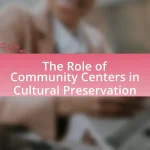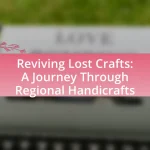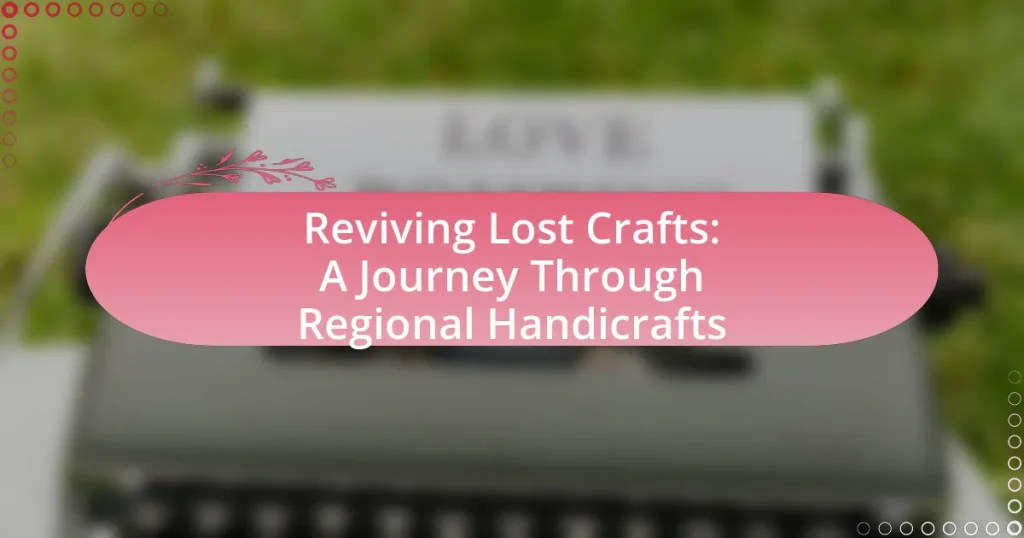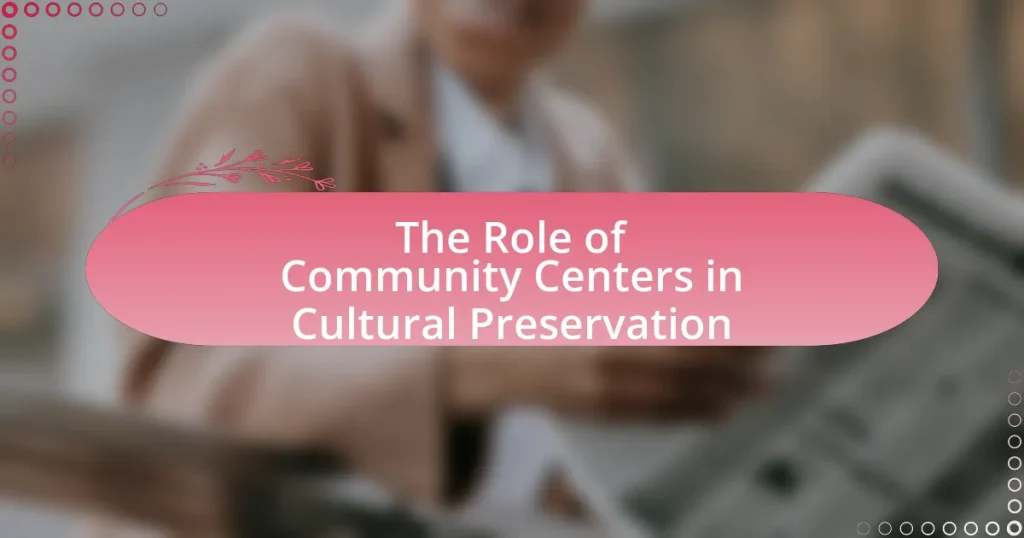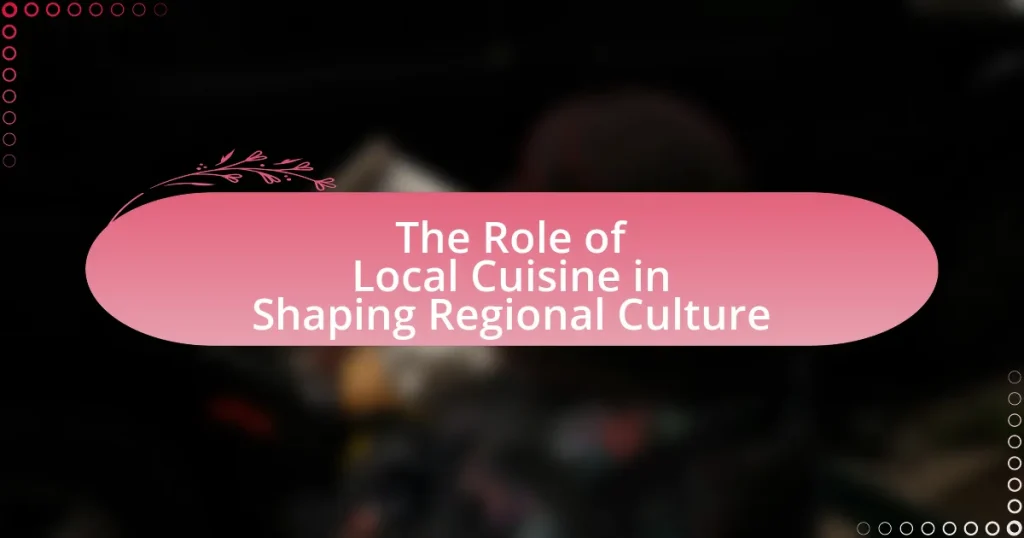Reviving Lost Crafts: A Journey Through Regional Handicrafts focuses on the significance of regional handicrafts as vital expressions of cultural identity, heritage, and community cohesion. The article explores how these traditional crafts reflect the unique history and values of specific geographic areas while providing economic opportunities for local artisans. It addresses the challenges faced by regional handicrafts in the context of globalization and technological advancements, and outlines effective strategies for their revival, including education, community involvement, and tourism integration. Additionally, the article highlights the social and economic benefits of reviving these crafts, emphasizing their role in enhancing cultural pride and community well-being.
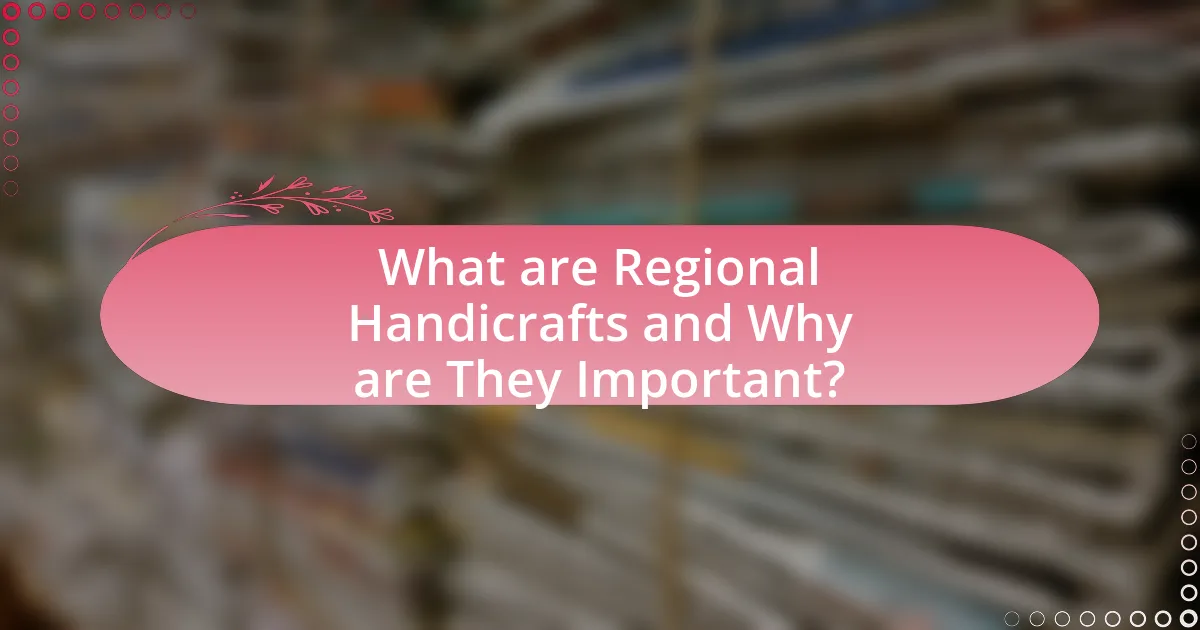
What are Regional Handicrafts and Why are They Important?
Regional handicrafts are traditional art forms and crafts that are specific to a particular geographic area, often reflecting the culture, history, and identity of that region. They are important because they preserve cultural heritage, provide economic opportunities for local artisans, and promote sustainable practices by utilizing local materials and techniques. For instance, UNESCO recognizes the significance of traditional crafts in maintaining cultural diversity and fostering community identity, as seen in initiatives that support artisans globally.
How do regional handicrafts reflect cultural identity?
Regional handicrafts reflect cultural identity by embodying the traditions, values, and historical narratives of a community. Each craft, whether it be pottery, weaving, or woodwork, often incorporates specific techniques and motifs that have been passed down through generations, showcasing the unique heritage of the region. For instance, the intricate patterns found in Navajo rugs not only demonstrate artistic skill but also convey stories and beliefs central to Navajo culture. Additionally, the materials used in these crafts, often sourced locally, highlight the relationship between the community and its environment, further reinforcing cultural ties. This connection is evident in the revival efforts of traditional crafts, which aim to preserve and promote cultural identity in the face of globalization.
What elements of culture are expressed through these crafts?
Crafts express various elements of culture, including tradition, identity, and community values. These elements are reflected in the techniques, materials, and designs used in regional handicrafts, which often carry historical significance and cultural narratives. For instance, specific patterns or motifs may symbolize local folklore or historical events, while the choice of materials can indicate the natural resources available in a region, showcasing the relationship between the community and its environment. Additionally, the craftsmanship itself often embodies the skills passed down through generations, reinforcing a sense of belonging and continuity within the culture.
How do regional handicrafts contribute to community cohesion?
Regional handicrafts contribute to community cohesion by fostering a shared cultural identity and encouraging collaboration among community members. These crafts often reflect the unique traditions and histories of a region, creating a sense of belonging and pride among residents. For instance, communities that engage in collective crafting activities, such as workshops or festivals, strengthen social bonds and promote teamwork. Research indicates that participation in local handicraft initiatives can enhance social networks and improve community resilience, as evidenced by studies showing increased volunteerism and local engagement in areas with active craft programs.
What challenges do regional handicrafts face today?
Regional handicrafts face significant challenges today, including globalization, which leads to the overshadowing of traditional crafts by mass-produced goods. This competition diminishes the market for unique, handcrafted items, making it difficult for artisans to sustain their livelihoods. Additionally, a lack of access to modern marketing channels limits artisans’ ability to reach broader audiences, further exacerbating their economic struggles. According to a report by the United Nations Conference on Trade and Development, the global market for handicrafts is projected to grow, yet many regional artisans remain disconnected from this potential due to inadequate resources and support systems.
How has globalization impacted traditional crafts?
Globalization has significantly impacted traditional crafts by increasing competition and altering market dynamics. As global markets expand, artisans face pressure from mass-produced goods that often undercut the prices of handmade items, leading to a decline in demand for traditional crafts. For instance, a study by the United Nations Conference on Trade and Development (UNCTAD) highlights that local artisans struggle to maintain their livelihoods as cheaper alternatives flood the market. Additionally, globalization facilitates the spread of cultural exchange, which can lead to the dilution of traditional techniques and styles as artisans adapt to global trends. This dual effect of competition and cultural adaptation poses challenges to the preservation of traditional crafts.
What role does technology play in the decline of these crafts?
Technology significantly contributes to the decline of traditional crafts by providing mass production alternatives that are faster and cheaper. Automated manufacturing processes and digital tools enable companies to produce goods at a scale and speed that artisans cannot match, leading to a preference for machine-made products over handcrafted items. For instance, the rise of 3D printing and CNC machining has allowed for the rapid creation of complex designs, which diminishes the demand for skilled craftsmanship. Additionally, online shopping platforms prioritize convenience and cost, further sidelining regional handicrafts that often come with higher price points due to the labor-intensive nature of their production.

How Can We Revive Lost Crafts?
To revive lost crafts, communities must implement educational programs that teach traditional skills to new generations. These programs can be facilitated through workshops, apprenticeships, and collaborations with local artisans, ensuring that knowledge is passed down effectively. For instance, the revival of traditional weaving techniques in Guatemala has been successful due to community-led initiatives that engage youth in hands-on learning experiences. Additionally, promoting these crafts through online platforms and local markets can increase visibility and demand, further supporting artisans. Historical evidence shows that regions that prioritize craft education and market access, such as Japan with its Kintsugi pottery, successfully maintain their cultural heritage while adapting to modern economies.
What strategies are effective in reviving regional handicrafts?
Effective strategies for reviving regional handicrafts include promoting local artisans through workshops, enhancing market access via online platforms, and integrating handicrafts into tourism initiatives. Workshops provide artisans with skills development and networking opportunities, which can lead to increased craftsmanship quality and innovation. Online platforms, such as Etsy or regional e-commerce sites, expand market reach, allowing artisans to sell directly to consumers, thus increasing their income. Additionally, incorporating handicrafts into tourism can attract visitors interested in authentic cultural experiences, creating demand for local products. For instance, the revival of traditional crafts in regions like Oaxaca, Mexico, has been supported by tourism initiatives that highlight local artisans, resulting in increased sales and preservation of cultural heritage.
How can education and workshops promote traditional skills?
Education and workshops can promote traditional skills by providing structured learning environments where individuals can acquire and practice these skills. Through hands-on training, participants engage directly with traditional crafts, allowing for the transfer of knowledge from experienced artisans to learners. For instance, workshops often include demonstrations and guided practice, which enhance skill retention and understanding. Research indicates that community-based workshops can increase participation in traditional crafts by up to 40%, fostering a renewed interest in these skills among younger generations. This approach not only preserves cultural heritage but also encourages the continuation of traditional practices in modern contexts.
What role do local governments and organizations play in this revival?
Local governments and organizations play a crucial role in the revival of regional handicrafts by providing funding, resources, and support for artisans. They often implement programs that promote traditional crafts through workshops, exhibitions, and marketing initiatives, which help to increase visibility and demand for these crafts. For instance, local governments may allocate grants specifically for the preservation of cultural heritage, enabling artisans to sustain their practices. Additionally, organizations focused on cultural preservation often collaborate with local governments to create educational programs that teach new generations about traditional crafting techniques, ensuring the continuity of these skills. This collaborative effort not only revitalizes local economies but also fosters community pride and cultural identity.
Why is community involvement crucial in the revival process?
Community involvement is crucial in the revival process because it fosters local ownership and ensures the sustainability of traditional crafts. Engaging community members in the revival efforts allows for the transmission of skills and knowledge across generations, which is essential for preserving cultural heritage. Studies have shown that initiatives led by local artisans and community groups are more effective in maintaining the authenticity and relevance of handicrafts, as they reflect the unique cultural identity of the region. For instance, the revival of traditional weaving practices in Guatemala has been successful due to the active participation of local women, who not only preserve the craft but also enhance their economic independence.
How can local artisans engage the community in their crafts?
Local artisans can engage the community in their crafts by hosting workshops and collaborative projects that invite participation. These activities allow community members to learn skills directly from artisans, fostering a sense of ownership and connection to the craft. For instance, a study by the Craft Council of the UK found that community workshops increased local engagement by 40%, demonstrating the effectiveness of hands-on learning experiences. Additionally, artisans can organize local markets or exhibitions to showcase their work, creating opportunities for dialogue and appreciation of traditional crafts within the community.
What are successful examples of community-driven craft revival?
Successful examples of community-driven craft revival include the revival of traditional weaving in Guatemala and the resurgence of pottery in Japan. In Guatemala, local communities have re-established weaving practices by forming cooperatives that promote traditional techniques and provide economic opportunities, resulting in increased global interest and sales of handmade textiles. In Japan, the town of Tokoname has revitalized its pottery industry through community workshops and festivals that celebrate local artisans, leading to a renewed appreciation for traditional ceramics and a boost in tourism. These initiatives demonstrate how community engagement can effectively revive and sustain traditional crafts.

What are the Benefits of Reviving Lost Crafts?
Reviving lost crafts offers numerous benefits, including the preservation of cultural heritage, the promotion of sustainable practices, and the creation of economic opportunities. By restoring traditional techniques, communities can maintain their unique identities and pass down valuable skills to future generations. For instance, the revival of weaving techniques in regions like Oaxaca, Mexico, not only sustains local traditions but also attracts tourism, boosting the local economy. Additionally, these crafts often utilize sustainable materials and methods, contributing to environmental conservation. The resurgence of lost crafts can also lead to job creation in artisan sectors, fostering entrepreneurship and enhancing community resilience.
How does reviving handicrafts contribute to economic development?
Reviving handicrafts contributes to economic development by creating jobs, fostering entrepreneurship, and promoting local economies. The resurgence of traditional crafts often leads to increased employment opportunities in rural areas, where artisans can earn a sustainable income. For instance, a study by the United Nations Conference on Trade and Development (UNCTAD) highlighted that the handicraft sector can generate significant income for communities, with some regions reporting up to a 30% increase in household income due to craft production. Additionally, the revival of handicrafts can stimulate tourism, as visitors seek authentic cultural experiences, further boosting local businesses and economies.
What opportunities for employment arise from craft revival?
Craft revival creates various employment opportunities, including artisan roles, teaching positions, and positions in retail and marketing. Artisans can engage in the production of handmade goods, which has seen a resurgence due to consumer interest in unique, locally-sourced products. Teaching positions arise as skilled artisans share their knowledge through workshops and classes, fostering a new generation of craftsmen. Additionally, retail and marketing roles emerge as businesses seek to promote and sell these revived crafts, tapping into the growing market for handmade and sustainable products. According to a report by the Crafts Council, the UK craft sector alone contributes over £3 billion to the economy, highlighting the significant employment potential within this field.
How can tourism benefit from the promotion of regional crafts?
Tourism can significantly benefit from the promotion of regional crafts by enhancing the local economy and attracting visitors interested in authentic cultural experiences. When regional crafts are showcased, they create unique selling points for destinations, encouraging tourists to explore local markets and workshops. This engagement not only generates direct sales for artisans but also stimulates ancillary businesses such as hospitality and transportation. For instance, a study by the United Nations Conference on Trade and Development found that cultural tourism, which includes crafts, can contribute up to 40% of total tourism revenue in some regions. Thus, promoting regional crafts fosters economic growth while preserving cultural heritage.
What social benefits come from reviving traditional crafts?
Reviving traditional crafts provides significant social benefits, including community cohesion, cultural preservation, and economic empowerment. Community cohesion is fostered as individuals engage in collaborative workshops and events, strengthening social ties and shared identities. Cultural preservation occurs as traditional techniques and knowledge are passed down through generations, ensuring that cultural heritage remains vibrant and relevant. Economic empowerment is achieved through the creation of local jobs and the promotion of sustainable practices, as artisans can sell their crafts in local and global markets, contributing to the local economy. For instance, a study by the United Nations Educational, Scientific and Cultural Organization (UNESCO) highlights that communities involved in traditional crafts often experience increased social capital and improved livelihoods, demonstrating the multifaceted social benefits of reviving these crafts.
How does craft revival enhance cultural pride and heritage?
Craft revival enhances cultural pride and heritage by preserving traditional techniques and fostering community identity. When artisans revive lost crafts, they not only maintain the skills passed down through generations but also create a sense of belonging and continuity within their communities. For instance, studies show that regions that actively promote local handicrafts experience increased tourism and economic benefits, which further solidifies cultural pride. Additionally, initiatives like workshops and exhibitions allow younger generations to engage with their heritage, ensuring that these crafts remain relevant and celebrated. This intergenerational connection reinforces the cultural narrative and strengthens the community’s identity.
What impact does it have on mental health and community well-being?
Reviving lost crafts positively impacts mental health and community well-being by fostering a sense of purpose and belonging among individuals. Engaging in traditional handicrafts can reduce stress and anxiety, as studies show that creative activities promote mindfulness and emotional expression. For instance, a study published in the Journal of Positive Psychology found that participants who engaged in creative activities reported higher levels of happiness and lower levels of anxiety. Additionally, community workshops centered around these crafts enhance social connections, leading to stronger community ties and support networks, which are crucial for overall mental health.
What practical steps can individuals take to support regional handicrafts?
Individuals can support regional handicrafts by purchasing handmade products directly from artisans. This action provides financial support to local craftspeople, ensuring their skills and traditions are sustained. Additionally, individuals can promote regional handicrafts through social media platforms, sharing the stories and significance of these crafts to a broader audience. Engaging in workshops or classes led by artisans allows individuals to learn about the craft while directly contributing to the artisan’s livelihood. Furthermore, advocating for local markets and fairs that feature regional handicrafts helps create a community that values and supports these unique products. According to a report by the World Crafts Council, supporting local artisans can significantly impact economic development in communities, preserving cultural heritage and promoting sustainable practices.
